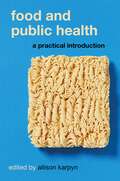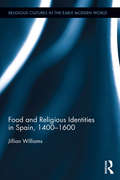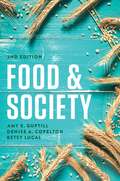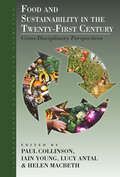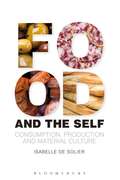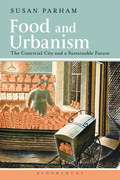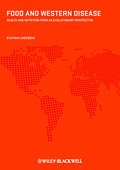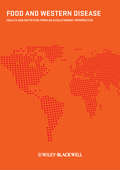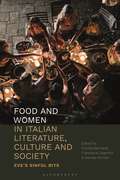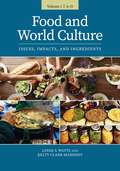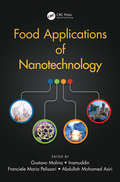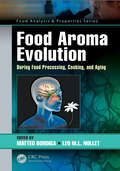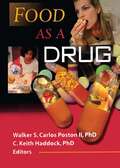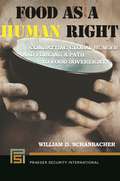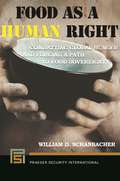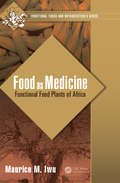- Table View
- List View
Food and Public Health: A Practical Introduction
A new introduction to public health's most elemental topic Food is baked in to most things that public health is and does. But for a field charged with carrying torches as divergent as anti-hunger and anti-obesity, it's unlikely, even impossible, to shape a unified approach to complex concepts like food environment, food access, or even nutrition. Food and Public Health offers a contextualized, accessible introduction to understanding the foundations (and contradictions) at the intersection of these two topics. It distills the historical, political, sociological, and scientific factors influencing what we eat and where our food comes from, then offers actionable insights for future nutritionists, social workers, dietitians, and researchers in public health. Guiding the reader through more than a century of food-focused regulation, policy, and education, Food and Public Health is an essential introduction to: · food production and availability on a global and neighborhood scale · dietary guidelines, agricultural subsidies, rationing, and other attempts by governments to shape their citizens' diets · best practices in health promotion and chronic disease prevention · food insecurity and its paradoxical role as driver of both hunger and obesity Enriched with real-world examples and case studies, Food and Public Health offers a crucial link between kitchen tables and populations for the classroom.
Food and Religious Identities in Spain, 1400-1600 (Religious Cultures in the Early Modern World)
by Jillian WilliamsIn the late fourteenth century, the Iberian Peninsula was home to three major religions which coexisted in relative peace. Over the next two centuries, various political and social factors changed the face of Iberia dramatically. This book examines this period of dynamic change in Iberian history through the lens of food and its relationship to religious identity. It also provides a basis for further study of the connection between food and identities of all types. This study explores the role of food as an expression of religious identity made evident in things like fasting, feasting, ingredient choices, preparation methods and commensal relations. It considers the role of food in the formation and redefinition of religious identities throughout this period and its significance in the maintenance of ideological and physical boundaries between faiths. This is an insightful and unique look into inter-religious dynamics. It will therefore be of great interest to scholars of religious studies, early modern European history and food studies.
Food and Religious Identities in Spain, 1400-1600 (Religious Cultures in the Early Modern World)
by Jillian WilliamsIn the late fourteenth century, the Iberian Peninsula was home to three major religions which coexisted in relative peace. Over the next two centuries, various political and social factors changed the face of Iberia dramatically. This book examines this period of dynamic change in Iberian history through the lens of food and its relationship to religious identity. It also provides a basis for further study of the connection between food and identities of all types. This study explores the role of food as an expression of religious identity made evident in things like fasting, feasting, ingredient choices, preparation methods and commensal relations. It considers the role of food in the formation and redefinition of religious identities throughout this period and its significance in the maintenance of ideological and physical boundaries between faiths. This is an insightful and unique look into inter-religious dynamics. It will therefore be of great interest to scholars of religious studies, early modern European history and food studies.
Food and Society: Principles and Paradoxes
by Amy E. Guptill Denise A. Copelton Betsy LucalThis popular and engaging text, now revised in a second edition, offers readers a social perspective on food, food practices, and the modern food system. It engages readers' curiosity by highlighting several paradoxes: how food is both individual and social, reveals both distinction and conformity, and, in the contemporary global era, comes from everywhere but nowhere in particular. With updates and enhancements throughout, the new edition provides an empirically deep, multifaceted, and coherent introduction to this fascinating field. Each chapter begins with a vivid case study, proceeds through a rich discussion of research insights, and ends with discussion questions and suggested resources. Chapter topics include food's role in socialization, identity, health and social change, as well as food marketing and the changing global food system. The new edition gives more focused attention to labor (both paid and unpaid) in all aspects of the food system. In synthesizing insights from diverse fields of social inquiry, the book addresses issues of culture, structure, and social inequality throughout. Written in a lively style, this book will continue to be both accessible and revealing to beginning and intermediate students alike.
Food and Sustainability in the Twenty-First Century: Cross-Disciplinary Perspectives (Anthropology of Food & Nutrition #9)
by Paul Collinson Iain Young Lucy Antal Helen MacbethSustainability is one of the great problems facing food production today. Using cross-disciplinary perspectives from international scholars working in social, cultural and biological anthropology, ecology and environmental biology, this volume brings many new perspectives to the problems we face. Its cross-disciplinary framework of chapters with local, regional and continental perspectives provides a global outlook on sustainability issues. These case studies will appeal to those working in public sector agencies, NGOs, consultancies and other bodies focused on food security, human nutrition and environmental sustainability.
Food and Sustainability in the Twenty-First Century: Cross-Disciplinary Perspectives (Anthropology of Food & Nutrition #9)
by Paul Collinson, Iain Young, Lucy Antal and Helen MacbethSustainability is one of the great problems facing food production today. Using cross-disciplinary perspectives from international scholars working in social, cultural and biological anthropology, ecology and environmental biology, this volume brings many new perspectives to the problems we face. Its cross-disciplinary framework of chapters with local, regional and continental perspectives provides a global outlook on sustainability issues. These case studies will appeal to those working in public sector agencies, NGOs, consultancies and other bodies focused on food security, human nutrition and environmental sustainability.
Food and the Self: Consumption, Production and Material Culture (Materializing Culture)
by Isabelle De SolierWe often hear that selves are no longer formed through producing material things at work, but by consuming them in leisure, leading to 'meaningless' modern lives. This important book reveals the cultural shift to be more complex, demonstrating how people in postindustrial societies strive to form meaningful and moral selves through both the consumption and production of material culture in leisure. Focusing on the material culture of food, the book explores these theoretical questions through an ethnography of those individuals for whom food is central to their self: 'foodies'. It examines what foodies do, and why they do it, through an in-depth study of their lived experiences. The book uncovers how food offers a means of shaping the self not as a consumer but as an amateur who engages in both the production and consumption of material culture and adopts a professional approach which reveals the new moralities of productive leisure in self-formation. The chapters examine a variety of practices, from fine dining and shopping to cooking and blogging, and include rare data on how people use media such as cookbooks, food television, and digital food media in their everyday life.This book is ideal for students, scholars, and anyone interested in the meaning of food in modern life.
Food and the Self: Consumption, Production and Material Culture (Materializing Culture)
by Isabelle de SolierWe often hear that selves are no longer formed through producing material things at work, but by consuming them in leisure, leading to 'meaningless' modern lives. This important book reveals the cultural shift to be more complex, demonstrating how people in postindustrial societies strive to form meaningful and moral selves through both the consumption and production of material culture in leisure. Focusing on the material culture of food, the book explores these theoretical questions through an ethnography of those individuals for whom food is central to their self: 'foodies'. It examines what foodies do, and why they do it, through an in-depth study of their lived experiences. The book uncovers how food offers a means of shaping the self not as a consumer but as an amateur who engages in both the production and consumption of material culture and adopts a professional approach which reveals the new moralities of productive leisure in self-formation. The chapters examine a variety of practices, from fine dining and shopping to cooking and blogging, and include rare data on how people use media such as cookbooks, food television, and digital food media in their everyday life.This book is ideal for students, scholars, and anyone interested in the meaning of food in modern life.
Food and Urbanism: The Convivial City and a Sustainable Future
by Susan ParhamCities are home to over fifty percent of the world's population, a figure which is expected to increase enormously by 2050. Despite the growing demand on urban resources and infrastructure, food is still often overlooked as a key factor in planning and designing cities. Without incorporating food into the design process – how it is grown, transported, and bought, cooked, eaten and disposed of – it is impossible to create truly resilient and convivial urbanism.Moving from the table and home garden to the town, city, and suburbs, Food and Urbanism explores the connections between food and place in past and present design practices. The book also looks to future methods for extending the 'gastronomic' possibilities of urban space. Supported by examples from places across the world, including the UK, Norway, Germany, France, Spain, Portugal, Greece, Romania, Australia and the USA, the book offers insights into how the interplay of physical design and socio-spatial practices centred around food can help to maintain socially rich, productive and sustainable urban space. Susan Parham brings together the latest research from a number of disciplines – urban planning, food studies, sociology, geography, and design – with her own fieldwork on a range of foodscapes to highlight the fundamental role food has to play in shaping the urban future.
Food and Urbanism: The Convivial City and a Sustainable Future
by Susan ParhamCities are home to over fifty percent of the world's population, a figure which is expected to increase enormously by 2050. Despite the growing demand on urban resources and infrastructure, food is still often overlooked as a key factor in planning and designing cities. Without incorporating food into the design process – how it is grown, transported, and bought, cooked, eaten and disposed of – it is impossible to create truly resilient and convivial urbanism.Moving from the table and home garden to the town, city, and suburbs, Food and Urbanism explores the connections between food and place in past and present design practices. The book also looks to future methods for extending the 'gastronomic' possibilities of urban space. Supported by examples from places across the world, including the UK, Norway, Germany, France, Spain, Portugal, Greece, Romania, Australia and the USA, the book offers insights into how the interplay of physical design and socio-spatial practices centred around food can help to maintain socially rich, productive and sustainable urban space. Susan Parham brings together the latest research from a number of disciplines – urban planning, food studies, sociology, geography, and design – with her own fieldwork on a range of foodscapes to highlight the fundamental role food has to play in shaping the urban future.
Food and Western Disease: Health and Nutrition from an Evolutionary Perspective
by Staffan LindebergNutrition science is a highly fractionated, contentious field with rapidly changing viewpoints on both minor and major issues impacting on public health. With an evolutionary perspective as its basis, this exciting book provides a framework by which the discipline can finally be coherently explored. By looking at what we know of human evolution and disease in relation to the diets that humans enjoy now and prehistorically, the book allows the reader to begin to truly understand the link between diet and disease in the Western world and move towards a greater knowledge of what can be defined as the optimal human diet. Written by a leading expert Covers all major diseases, including cancer, heart disease, obesity, stroke and dementia Details the benefits and risks associated with the Palaeolithic diet Draws conclusions on key topics including sustainable nutrition and the question of healthy eating This important book provides an exciting and useful insight into this fascinating subject area and will be of great interest to nutritionists, dietitians and other members of the health professions. Evolutionary biologists and anthropologists will also find much of interest within the book. All university and research establishments where nutritional sciences, medicine, food science and biological sciences are studied and taught should have copies of this title.
Food and Western Disease: Health and Nutrition from an Evolutionary Perspective
by Staffan LindebergNutrition science is a highly fractionated, contentious field with rapidly changing viewpoints on both minor and major issues impacting on public health. With an evolutionary perspective as its basis, this exciting book provides a framework by which the discipline can finally be coherently explored. By looking at what we know of human evolution and disease in relation to the diets that humans enjoy now and prehistorically, the book allows the reader to begin to truly understand the link between diet and disease in the Western world and move towards a greater knowledge of what can be defined as the optimal human diet. Written by a leading expert Covers all major diseases, including cancer, heart disease, obesity, stroke and dementia Details the benefits and risks associated with the Palaeolithic diet Draws conclusions on key topics including sustainable nutrition and the question of healthy eating This important book provides an exciting and useful insight into this fascinating subject area and will be of great interest to nutritionists, dietitians and other members of the health professions. Evolutionary biologists and anthropologists will also find much of interest within the book. All university and research establishments where nutritional sciences, medicine, food science and biological sciences are studied and taught should have copies of this title.
Food and Women in Italian Literature, Culture and Society: Eve's Sinful Bite
by Claudia Bernardi, Francesca Calamita and Daniele De FeoThis book explores how women's relationship with food has been represented in Italian literature, cinema, scientific writings and other forms of cultural expression from the 19th century to the present.Italian women have often been portrayed cooking and serving meals to others, while denying themselves the pleasure of the table. The collection presents a comprehensive understanding of the symbolic meanings associated with food and of the way these intersect with Italian women's socio-cultural history and the feminist movement.From case studies on Sophia Loren and Elena Ferrante, to analyses of cookbooks by Italian chefs, each chapter examines the unique contribution Italian culture has made to perceiving and portraying women in a specific relation to food, addressing issues of gender, identity and politics of the body.
Food and Women in Italian Literature, Culture and Society: Eve's Sinful Bite
This book explores how women's relationship with food has been represented in Italian literature, cinema, scientific writings and other forms of cultural expression from the 19th century to the present.Italian women have often been portrayed cooking and serving meals to others, while denying themselves the pleasure of the table. The collection presents a comprehensive understanding of the symbolic meanings associated with food and of the way these intersect with Italian women's socio-cultural history and the feminist movement.From case studies on Sophia Loren and Elena Ferrante, to analyses of cookbooks by Italian chefs, each chapter examines the unique contribution Italian culture has made to perceiving and portraying women in a specific relation to food, addressing issues of gender, identity and politics of the body.
Food and World Culture [2 volumes]: Issues, Impacts, and Ingredients [2 volumes]
by Linda S. Watts Kelty Clark-MahoneyThis book uses food as a lens through which to explore important matters of society and culture. In exploring why and how people eat around the globe, the text focuses on issues of health, conflict, struggle, contest, inequality, and power.Whether because of its necessity, pleasure, or ubiquity, the world of food (and its lore) proves endlessly fascinating to most people. The story of food is a narrative filled with both human striving and human suffering. However, many of today's diners are only dimly aware of the human price exacted for that comforting distance from the lived-world realities of food justice struggles. With attention to food issues ranging from local farming practices to global supply chains, this book examines how food&’s history and geography remain inextricably linked to sociopolitical experiences of trauma connected with globalization, such as colonization, conquest, enslavement, and oppression.The main text is structured alphabetically around a set of 70 ingredients, from almonds to yeast. Each ingredient's story is accompanied by recipes. Along with the food profiles, the encyclopedia features sidebars. These are short discussions of topics of interest related to food, including automats, diners, victory gardens, and food at world&’s fairs. This project also brings a social justice perspective to its content—weighing debates concerning food access, equity, insecurity, and politics.
Food and World Culture [2 volumes]: Issues, Impacts, and Ingredients [2 volumes]
by Linda S. Watts Kelty Clark-MahoneyThis book uses food as a lens through which to explore important matters of society and culture. In exploring why and how people eat around the globe, the text focuses on issues of health, conflict, struggle, contest, inequality, and power.Whether because of its necessity, pleasure, or ubiquity, the world of food (and its lore) proves endlessly fascinating to most people. The story of food is a narrative filled with both human striving and human suffering. However, many of today's diners are only dimly aware of the human price exacted for that comforting distance from the lived-world realities of food justice struggles. With attention to food issues ranging from local farming practices to global supply chains, this book examines how food&’s history and geography remain inextricably linked to sociopolitical experiences of trauma connected with globalization, such as colonization, conquest, enslavement, and oppression.The main text is structured alphabetically around a set of 70 ingredients, from almonds to yeast. Each ingredient's story is accompanied by recipes. Along with the food profiles, the encyclopedia features sidebars. These are short discussions of topics of interest related to food, including automats, diners, victory gardens, and food at world&’s fairs. This project also brings a social justice perspective to its content—weighing debates concerning food access, equity, insecurity, and politics.
Food Applications of Nanotechnology
by Gustavo Molina Inamuddin Franciele Maria Pelissari Abdullah Mohamed AsiriNanotechnology has developed remarkably in recent years and, applied in the food industry, has allowed new industrial advances, the improvement of conventional technologies, and the commercialization of products with new features and functionalities. This progress offers the potential to increase productivity for producers, food security for consumers and economic growth for industries. Food Applications of Nanotechnology presents the main advances of nanotechnology for food industry development. The fundamental concepts of the technique are presented, followed by examples of application in several sectors, such as the enhancement of flavor, color and sensory characteristics; the description of the general concepts of nano-supplements, antimicrobial nanoparticles and other active compounds into food; and developments in the field of packaging, among others. In addition, this work updates readers on the industrial development and the main regulatory aspects for the safety and commercialization of nanofoods. Features: Provides a general overview of nanotechnology in the food industry Discusses the current status of the production and use of nanomaterials as food additives Covers the technological developments in the areas of flavor, color and sensory characteristics of food and food additives Reviews nanosupplements and how they provide improvements in nutritional functionality Explains the antibacterial properties of nanoparticles for food applications This book will serve food scientists and technologists, food engineers, chemists and innovators working in food or ingredient research and new product development. Gustavo Molina is associate professor at the UFVJM (Diamantina—Brazil) in Food Engineering and head of the Laboratory of Food Biotechnology and conducts scientific and technical research. His research interests are focused on industrial biotechnology. Dr. Inamuddin is currently working as assistant professor in the chemistry department of Faculty of Science, King Abdulaziz University, Jeddah, Saudi Arabia. He is also a permanent faculty member (assistant professor) at the Department of Applied Chemistry, Aligarh Muslim University, Aligarh, India. He has extensive research experience in multidisciplinary fields of analytical chemistry, materials chemistry, and electrochemistry and, more specifically, renewable energy and environment. Prof. Abdullah M. Asiri is professor of organic photochemistry and has been the head of the chemistry department at King Abdulaziz University since October 2009, as well as the director of the Center of Excellence for Advanced Materials Research (CEAMR) since 2010. His research interest covers color chemistry, synthesis of novel photochromic and thermochromic systems, synthesis of novel coloring matters and dyeing of textiles, materials chemistry, nanochemistry and nanotechnology, polymers, and plastics. Franciele Maria Pelissari graduated in Food Engineering; earned her master’s degree (2009) at the University of Londrina (UEL), Londrina, Brazil; and her PhD (2013) at the University of Campinas (Unicamp), Campinas, Brazil. Since 2013, she has been associate professor at the Institute of Science and Technology program at the Federal University of Jequitinhonha and Mucuri (UFVJM), Diamantina, Brazil, in Food Engineering, and also full professor in the graduate program in Food Science and Technology.
Food Applications of Nanotechnology
by Gustavo Molina Inamuddin Franciele Maria Pelissari Abdullah Mohamed AsiriNanotechnology has developed remarkably in recent years and, applied in the food industry, has allowed new industrial advances, the improvement of conventional technologies, and the commercialization of products with new features and functionalities. This progress offers the potential to increase productivity for producers, food security for consumers and economic growth for industries. Food Applications of Nanotechnology presents the main advances of nanotechnology for food industry development. The fundamental concepts of the technique are presented, followed by examples of application in several sectors, such as the enhancement of flavor, color and sensory characteristics; the description of the general concepts of nano-supplements, antimicrobial nanoparticles and other active compounds into food; and developments in the field of packaging, among others. In addition, this work updates readers on the industrial development and the main regulatory aspects for the safety and commercialization of nanofoods. Features: Provides a general overview of nanotechnology in the food industry Discusses the current status of the production and use of nanomaterials as food additives Covers the technological developments in the areas of flavor, color and sensory characteristics of food and food additives Reviews nanosupplements and how they provide improvements in nutritional functionality Explains the antibacterial properties of nanoparticles for food applications This book will serve food scientists and technologists, food engineers, chemists and innovators working in food or ingredient research and new product development. Gustavo Molina is associate professor at the UFVJM (Diamantina—Brazil) in Food Engineering and head of the Laboratory of Food Biotechnology and conducts scientific and technical research. His research interests are focused on industrial biotechnology. Dr. Inamuddin is currently working as assistant professor in the chemistry department of Faculty of Science, King Abdulaziz University, Jeddah, Saudi Arabia. He is also a permanent faculty member (assistant professor) at the Department of Applied Chemistry, Aligarh Muslim University, Aligarh, India. He has extensive research experience in multidisciplinary fields of analytical chemistry, materials chemistry, and electrochemistry and, more specifically, renewable energy and environment. Prof. Abdullah M. Asiri is professor of organic photochemistry and has been the head of the chemistry department at King Abdulaziz University since October 2009, as well as the director of the Center of Excellence for Advanced Materials Research (CEAMR) since 2010. His research interest covers color chemistry, synthesis of novel photochromic and thermochromic systems, synthesis of novel coloring matters and dyeing of textiles, materials chemistry, nanochemistry and nanotechnology, polymers, and plastics. Franciele Maria Pelissari graduated in Food Engineering; earned her master’s degree (2009) at the University of Londrina (UEL), Londrina, Brazil; and her PhD (2013) at the University of Campinas (Unicamp), Campinas, Brazil. Since 2013, she has been associate professor at the Institute of Science and Technology program at the Federal University of Jequitinhonha and Mucuri (UFVJM), Diamantina, Brazil, in Food Engineering, and also full professor in the graduate program in Food Science and Technology.
Food Aroma Evolution: During Food Processing, Cooking, and Aging (Food Analysis & Properties)
by Matteo Bordiga Leo M. L. NolletOf the five senses, smell is the most direct and food aromas are the key drivers of our flavor experience. They are crucial for the synergy of food and drinks. Up to 80% of what we call taste is actually aroma. Food Aroma Evolution: During Food Processing, Cooking, and Aging focuses on the description of the aroma evolution in several food matrices. Not only cooking, but also processing (such as fermentation) and aging are responsible for food aroma evolution. A comprehensive evaluation of foods requires that analytical techniques keep pace with the available technology. As a result, a major objective in the chemistry of food aroma is concerned with the application and continual development of analytical methods. This particularly important aspect is discussed in depth in a dedicated section of the book. Features Covers aromatic evolution of food as it is affected by treatment Focuses on food processing, cooking, and aging Describes both classic and new analytical techniques Explains how the flavor perception results are influenced by other food constituents The book comprises a good mix of referenced research with practical applications, also reporting case studies of these various applications of novel technologies. This text represents a comprehensive reference book for students, educators, researchers, food processors, and food industry personnel providing an up-to-date insight. The range of techniques and materials covered provides engineers and scientists working in the food industry with a valuable resource for their work. Also available in the Food Analysis & Properties Series: Ambient Mass Spectroscopy Techniques in Food and the Environment, edited by Leo M.L. Nollet and Basil K. Munjanja (ISBN: 9781138505568) Hyperspectral Imaging Analysis and Applications for Food Quality, edited by N.C. Basantia, Leo M.L. Nollet, and Mohammed Kamruzzaman (ISBN: 9781138630796) Fingerprinting Techniques in Food Authentication and Traceability, edited by Khwaja Salahuddin Siddiqi and Leo M.L. Nollet (ISBN: 9781138197671) For a complete list of books in this series, please visit our website at: www.crcpress.com/Food-Analysis--Properties/book-series/CRCFOODANPRO
Food Aroma Evolution: During Food Processing, Cooking, and Aging (Food Analysis & Properties)
by Matteo Bordiga, Leo M.L. NolletOf the five senses, smell is the most direct and food aromas are the key drivers of our flavor experience. They are crucial for the synergy of food and drinks. Up to 80% of what we call taste is actually aroma. Food Aroma Evolution: During Food Processing, Cooking, and Aging focuses on the description of the aroma evolution in several food matrices. Not only cooking, but also processing (such as fermentation) and aging are responsible for food aroma evolution. A comprehensive evaluation of foods requires that analytical techniques keep pace with the available technology. As a result, a major objective in the chemistry of food aroma is concerned with the application and continual development of analytical methods. This particularly important aspect is discussed in depth in a dedicated section of the book. Features Covers aromatic evolution of food as it is affected by treatment Focuses on food processing, cooking, and aging Describes both classic and new analytical techniques Explains how the flavor perception results are influenced by other food constituents The book comprises a good mix of referenced research with practical applications, also reporting case studies of these various applications of novel technologies. This text represents a comprehensive reference book for students, educators, researchers, food processors, and food industry personnel providing an up-to-date insight. The range of techniques and materials covered provides engineers and scientists working in the food industry with a valuable resource for their work. Also available in the Food Analysis & Properties Series: Ambient Mass Spectroscopy Techniques in Food and the Environment, edited by Leo M.L. Nollet and Basil K. Munjanja (ISBN: 9781138505568) Hyperspectral Imaging Analysis and Applications for Food Quality, edited by N.C. Basantia, Leo M.L. Nollet, and Mohammed Kamruzzaman (ISBN: 9781138630796) Fingerprinting Techniques in Food Authentication and Traceability, edited by Khwaja Salahuddin Siddiqi and Leo M.L. Nollet (ISBN: 9781138197671) For a complete list of books in this series, please visit our website at: www.crcpress.com/Food-Analysis--Properties/book-series/CRCFOODANPRO
Food as a Drug
by Walker S Poston C Keith HaddockFood as a Drug provides psychologists, psychiatrists, and counselors with a unique discussion about possible addictive qualities of some foods to assist clients who are struggling with obesity or eating disorders. Examining the pros and cons of treating eating disorders with an addictions model, this book also explores the tremendous societal and personal costs of eating disorders and obesity, such as increased risk of heart disease, health care costs, and death. Thorough and concise, Food as a Drug will assist you in providing better services to clients with these types of dilemmas.Comprehensive and current, this reference provides information on relevant topics, such as diet and behavior relationships; cross-cultural perspectives on the use of foods for medicinal purposes; regulatory perspectives on drugs, foods, and nutritional supplements; and whether foods have pharmacological properties. Food as a Drug address several important topics, such as: focusing on sugar to determine the effects of food additives on children's behavioral disorders, such as attention deficit disorder and hyperactivity addressing the role that your diet plays on serotonin levels, carbohydrate craving, and depression examining the phenomenological, psychological, and physiological correlations between overeating and how foods may be used to alleviate negative moods discussing the pros and cons of treating obesity and eating disorders with addiction modelsWritten by experts in the field, this book offers you in-depth studies and information about the nature of food as a potentially addictive substance. Food as a Drug will help you understand these difficult-to-treat conditions and offer clients better and more effective services.
Food as a Drug
by Walker S Poston C Keith HaddockFood as a Drug provides psychologists, psychiatrists, and counselors with a unique discussion about possible addictive qualities of some foods to assist clients who are struggling with obesity or eating disorders. Examining the pros and cons of treating eating disorders with an addictions model, this book also explores the tremendous societal and personal costs of eating disorders and obesity, such as increased risk of heart disease, health care costs, and death. Thorough and concise, Food as a Drug will assist you in providing better services to clients with these types of dilemmas.Comprehensive and current, this reference provides information on relevant topics, such as diet and behavior relationships; cross-cultural perspectives on the use of foods for medicinal purposes; regulatory perspectives on drugs, foods, and nutritional supplements; and whether foods have pharmacological properties. Food as a Drug address several important topics, such as: focusing on sugar to determine the effects of food additives on children's behavioral disorders, such as attention deficit disorder and hyperactivity addressing the role that your diet plays on serotonin levels, carbohydrate craving, and depression examining the phenomenological, psychological, and physiological correlations between overeating and how foods may be used to alleviate negative moods discussing the pros and cons of treating obesity and eating disorders with addiction modelsWritten by experts in the field, this book offers you in-depth studies and information about the nature of food as a potentially addictive substance. Food as a Drug will help you understand these difficult-to-treat conditions and offer clients better and more effective services.
Food as a Human Right: Combatting Global Hunger and Forging a Path to Food Sovereignty (Praeger Security International)
by William D. SchanbacherThis important work addresses the difficult ethical issues surrounding the accessibility of food to all people as a human right, and not a privilege that emerges because of social structure or benefit of geography.Food sovereignty—the right of peoples to define their own chosen food and agriculture, free of monopolization or threats—is the path to stopping global hunger. This book approaches the topic from a solutions-based perspective, discussing concrete policy providing for sovereignty, or control, of one's own food sources as a solution that, while controversial, offers more promise than do the actions of international organizations and trade agreements. Providing access to safe, healthy food is an ethical responsibility of the world's nations, not just a right of the elite or wealthy.This book presses the need to formulate policies that address the problems of poverty and hunger on a more humane and meaningful level. Organized thematically, chapters are based on such topics as food security, food sovereignty, human rights, and sustainability that focus on the global food system. Specific case studies provide examples of global hunger and poverty issues. Taken in its entirety, the book informs readers of how their food consumption might negatively affect the global poor, while its concluding chapters offer solutions for alleviating problems in the global food system.
Food as a Human Right: Combatting Global Hunger and Forging a Path to Food Sovereignty (Praeger Security International)
by William D. SchanbacherThis important work addresses the difficult ethical issues surrounding the accessibility of food to all people as a human right, and not a privilege that emerges because of social structure or benefit of geography.Food sovereignty—the right of peoples to define their own chosen food and agriculture, free of monopolization or threats—is the path to stopping global hunger. This book approaches the topic from a solutions-based perspective, discussing concrete policy providing for sovereignty, or control, of one's own food sources as a solution that, while controversial, offers more promise than do the actions of international organizations and trade agreements. Providing access to safe, healthy food is an ethical responsibility of the world's nations, not just a right of the elite or wealthy.This book presses the need to formulate policies that address the problems of poverty and hunger on a more humane and meaningful level. Organized thematically, chapters are based on such topics as food security, food sovereignty, human rights, and sustainability that focus on the global food system. Specific case studies provide examples of global hunger and poverty issues. Taken in its entirety, the book informs readers of how their food consumption might negatively affect the global poor, while its concluding chapters offer solutions for alleviating problems in the global food system.
Food as Medicine: Functional Food Plants of Africa (Functional Foods and Nutraceuticals)
by Maurice M. IwuThis comprehensive book documents African plants used for functional and medicinal foods. It contains more than 60 detailed monographs of African foods, describing foods with various characteristics such as prebiotic, probiotic, satiety, immune modulation, stress-reduction, sports performance, mental acuity, sleep-supporting, metabolic syndrome, antioxidant, and unsaturated fats. Plant description, botanical names and synonyms, plant part used, habitat and distribution, folk use, nutritional content, and chemistry are all fully detailed. The book highlights indigenous African food processing technologies up to the modern era.
